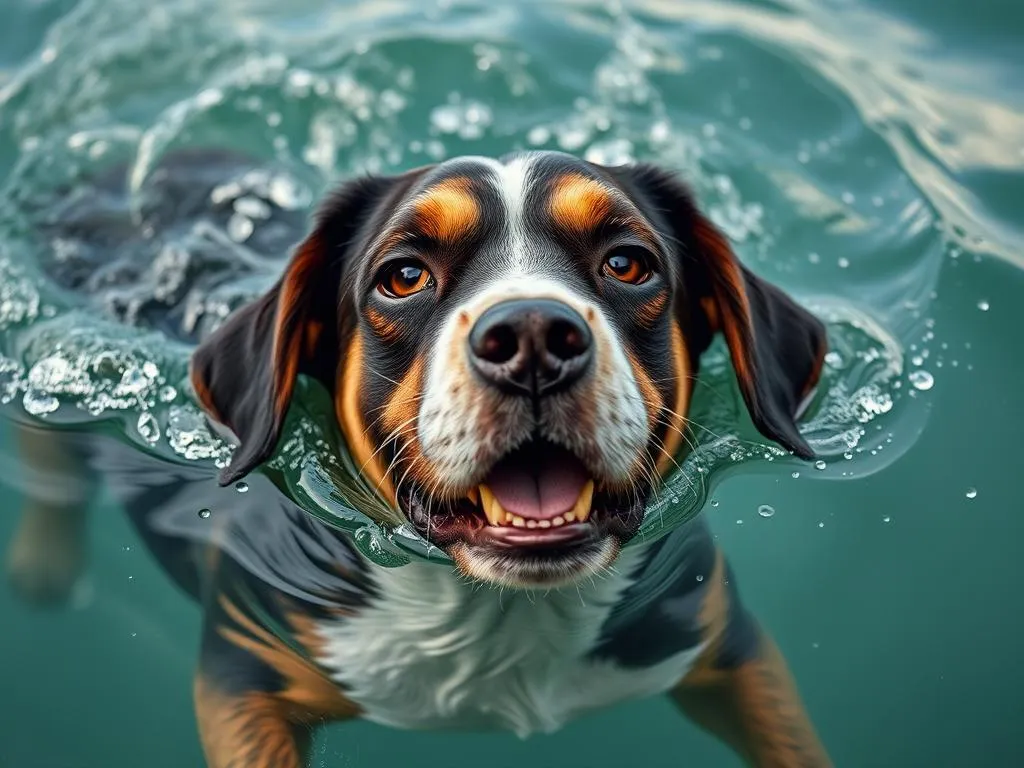
Introduction
Dogs are known for their playful nature, and many pet owners enjoy watching their furry friends frolic in water. But have you ever wondered, how do dogs know how to swim? This instinctive ability is an intriguing aspect of canine behavior that reflects both their evolutionary background and physical anatomy.
Understanding canine swimming behavior is essential for several reasons. First and foremost, swimming provides valuable health benefits for dogs, contributing to their physical fitness and mental well-being. On the flip side, there are potential concerns regarding dogs and water, such as safety issues and the risk of drowning. Therefore, exploring how dogs swim, their anatomical adaptations, and how to train them can help ensure a safe and enjoyable experience for both the dog and its owner.
This article will delve into the instinctive swimming abilities of dogs, examining their evolutionary traits, physical features, training techniques, and the myriad benefits of swimming for our four-legged friends.
The Instinctual Swimming Ability of Dogs
Evolutionary Perspective
The swimming ability of dogs can be traced back to their ancestors. Canines evolved from wolves, which were skilled swimmers, using their abilities to hunt and escape predators. This ancestral trait may have endowed modern dogs with an innate swimming instinct. Many breeds, especially those developed for water-related tasks, exhibit a natural affinity for swimming.
When comparing dogs to other animals that swim, such as otters and beavers, we can see that while dogs may not be as adept as these creatures, they possess unique adaptations that facilitate swimming. This evolutionary background suggests that swimming is not merely a learned behavior for many dogs; it is part of their genetic makeup.
The ‘Dog Paddle’ Technique
One of the most recognizable swimming styles in dogs is the “dog paddle.” This natural swimming technique involves dogs moving their legs in a circular motion while keeping their heads above water. The dog paddle is effective for several reasons: it allows dogs to maintain their buoyancy, propelling them forward while conserving energy.
The proficiency of this technique varies among breeds, with some naturally more adept swimmers than others. For instance, retrievers and spaniels typically demonstrate a more pronounced dog paddle, while brachycephalic breeds like bulldogs may struggle due to their body structure.
Factors Influencing Swimming Ability
While many dogs possess an instinctual ability to swim, individual factors can influence their performance in water. Breed differences play a significant role; water-loving breeds like Labrador Retrievers and Poodles have been bred for swimming, while others, such as Dachshunds or Bulldogs, may not swim as well due to their physical characteristics.
Age and physical condition also affect swimming ability. Puppies often exhibit a natural inclination to swim, but their coordination and stamina may limit them. Conversely, older dogs may require encouragement and support, especially if they have health issues or reduced mobility.
Anatomy of Dogs and Swimming
Physical Features that Aid Swimming
The anatomy of dogs is specifically designed to support their swimming capabilities. Key features include their limbs, tail, and body shape. Dogs possess muscular limbs that provide powerful propulsion, while their tails act as rudders, helping to steer and maintain balance in the water.
Additionally, buoyancy plays a crucial role in swimming. Dogs with a higher percentage of body fat may float better, allowing them to conserve energy while swimming. Conversely, dogs with a leaner physique may require more effort to stay afloat.
How Dogs’ Feet are Built for Water
Some dog breeds have anatomical adaptations that enhance their swimming abilities. For example, breeds like Newfoundlands and Portuguese Water Dogs possess webbed feet, which act like paddles, increasing their surface area for better propulsion.
In contrast, other breeds may have foot structures that are less suited for swimming. For example, terriers typically have smaller, narrower feet, which may not be as effective in water. Understanding these differences can help dog owners appreciate the diverse swimming capabilities among breeds.
Sensory Capabilities
Dogs’ sensory perceptions also play a significant role in how they navigate water. With a keen sense of smell and excellent hearing, dogs can detect scents and sounds above and below the water’s surface. This ability helps them orient themselves and locate their owners or other dogs while swimming.
Moreover, dogs possess a unique adaptation in their eyes that allows them to see well in low-light conditions, making them adept at swimming in various environments, whether in bright sunlight or murky waters.
Learning to Swim: Nature vs. Nurture
Natural Instincts vs. Training
While many dogs may exhibit an instinctual ability to swim, not all dogs are born with this skill. Some breeds may have a natural aversion to water or lack the confidence to swim. In these cases, early exposure to water is crucial for fostering comfort and familiarity.
By gradually introducing puppies to water, owners can help them develop a positive association with swimming. For dogs that show fear or hesitation, patience and encouragement are key components of the training process.
Teaching Your Dog to Swim
Teaching a dog how to swim can be a rewarding experience. Here’s a step-by-step guide to introducing your dog to water safely:
- Start Small: Begin with shallow water, allowing your dog to explore at their own pace.
- Use Positive Reinforcement: Reward your dog with treats and praise when they show interest in the water.
- Introduce Floating Toys: Use toys to encourage your dog to enter the water and retrieve them, promoting playfulness.
- Stay Close: Remain in the water with your dog, offering support and reassurance as they take their first swims.
- Gradually Increase Depth: As your dog gains confidence, gradually lead them into deeper water.
Overcoming Fear of Water
For dogs that are hesitant to swim, employing strategies to build their confidence is essential. Here are some effective methods:
- Positive Reinforcement: Use treats and praise to reward any progress your dog makes towards entering the water.
- Controlled Exposure: Gradually expose your dog to water, starting with wetting their paws and slowly moving to deeper sections.
- Pairing with Fun Activities: Engage your dog in fun activities near the water, such as playing fetch or running along the shore, to create positive associations.
Benefits of Swimming for Dogs
Physical Health Benefits
Swimming is an excellent exercise for dogs, providing numerous physical health benefits. It promotes cardiovascular health, strengthens muscles, and improves joint flexibility. As a low-impact exercise, swimming is particularly beneficial for dogs recovering from injuries or those with mobility issues, allowing them to maintain fitness without straining their joints.
Mental Health Benefits
Beyond physical health, swimming can significantly impact a dog’s mental well-being. The sensory stimulation of water, combined with the joy of play, can help alleviate stress and reduce anxiety. Swimming also offers dogs valuable socialization opportunities, allowing them to interact with other dogs and people, which is crucial for their emotional development.
Rehabilitation and Therapy
Swimming is often used as a form of rehabilitation for injured dogs. Veterinary professionals frequently recommend water therapy to help dogs recover from surgeries or injuries, as it minimizes the impact on joints while allowing for muscle strengthening. Additionally, senior dogs can benefit from swimming, as it helps maintain their mobility and quality of life as they age.
Safety Considerations for Dog Swimming
Choosing Safe Swimming Locations
Selecting safe swimming locations is essential for your dog’s safety. Here are some best practices to follow:
- Assess Water Quality: Ensure the water is clean and free from pollutants or harmful algae.
- Avoid Strong Currents: Steer clear of areas with strong currents, as they can pose a drowning risk.
- Supervise at All Times: Keep a watchful eye on your dog while they are in the water to intervene if necessary.
Equipment and Safety Gear
Certain breeds may benefit from flotation devices, especially those that are not strong swimmers or have physical limitations. A well-fitted dog life jacket can provide extra buoyancy and security in the water.
Additionally, using a leash while swimming can help you maintain control over your dog and prevent them from straying too far or getting into dangerous situations.
Signs of Distress in Dogs While Swimming
Recognizing signs of distress in dogs while swimming is crucial for their safety. Look for the following indicators:
- Fatigue: If your dog begins to struggle or swim in circles, they may be getting tired.
- Panic: Signs of panic include excessive splashing, barking, or attempting to climb out of the water.
- Difficulty Breathing: If your dog appears to be gasping for air or struggling to keep their head above water, immediate intervention is necessary.
In the event of distress, calmly guide your dog back to the shore or pool edge, and assess whether they require rest or medical attention.
Conclusion
In summary, exploring how do dogs know how to swim reveals a fascinating interplay of instinct, anatomy, and learned behavior. From their evolutionary background to their unique physical features, dogs are naturally equipped to navigate water with ease. While many dogs possess instinctual swimming abilities, training plays a vital role in developing confidence and proficiency in the water.
The benefits of swimming for dogs extend beyond physical fitness to include mental health and rehabilitation opportunities. However, ensuring safety during swimming activities is paramount, necessitating careful consideration of swimming locations, equipment, and signs of distress.
By understanding the complexities of canine swimming abilities, dog owners can provide their pets with enjoyable and safe swimming experiences, enriching their lives and strengthening the bond between dog and owner.









